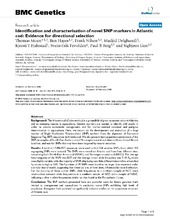| dc.description.abstract | Background The Atlantic cod (Gadus morhua) is a groundfish of great economic value in fisheries and an emerging species in aquaculture. Genetic markers are needed to identify wild stocks in order to ensure sustainable management, and for marker-assisted selection and pedigree determination in aquaculture. Here, we report on the development and evaluation of a large number of Single Nucleotide Polymorphism (SNP) markers from the alignment of Expressed Sequence Tag (EST) sequences in Atlantic cod. We also present basic population parameters of the SNPs in samples of North-East Arctic cod and Norwegian coastal cod obtained from three different localities, and test for SNPs that may have been targeted by natural selection. Results A total of 17,056 EST sequences were used to find 724 putative SNPs, from which 318 segregating SNPs were isolated. The SNPs were tested on Atlantic cod from four different sites, comprising both North-East Arctic cod (NEAC) and Norwegian coastal cod (NCC). The average heterozygosity of the SNPs was 0.25 and the average minor allele frequency was 0.18. FST values were highly variable, with the majority of SNPs displaying very little differentiation while others had FST values as high as 0.83. The FST values of 29 SNPs were found to be larger than expected under a strictly neutral model, suggesting that these loci are, or have been, influenced by natural selection. For the majority of these outlier SNPs, allele frequencies in a northern sample of NCC were intermediate between allele frequencies in a southern sample of NCC and a sample of NEAC, indicating a cline in allele frequencies similar to that found at the Pantophysin I locus. Conclusion The SNP markers presented here are powerful tools for future genetics work related to management and aquaculture. In particular, some SNPs exhibiting high levels of population divergence have potential to significantly enhance studies on the population structure of Atlantic cod. | en_US |
